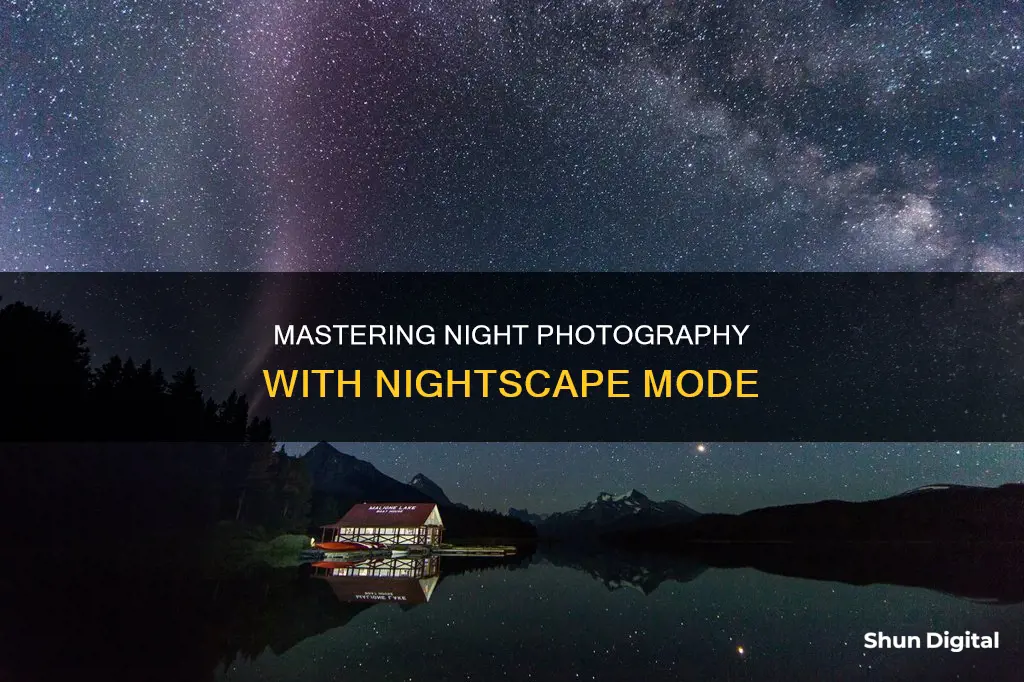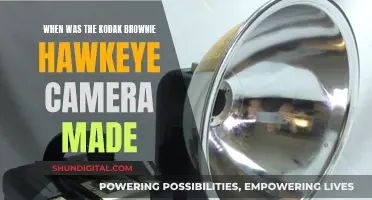
Nightscape mode is a camera feature that enhances night photography. It is designed to capture clear images in low-light conditions by utilising multi-frame exposure and AI technology. This mode helps to reduce noise and blur effects, allowing users to take bright and detailed photos even in challenging lighting situations. Nightscape mode is particularly useful for capturing nightscapes, which involve photographing landscapes or constellations under the night sky. While nightscapes can be challenging due to limited light, modern camera features like Nightscape mode make it easier for photographers to capture stunning images of the night sky and its surroundings.
| Characteristics | Values |
|---|---|
| Purpose | To capture a landscape-style image at night, including the Milky Way, a starry sky, or a favourite constellation |
| Type | Astrophotography |
| Light | Limited light is collected |
| Camera settings | Aperture, ISO, shutter speed |
| Aperture | Wide open, e.g. f/4.5 on a kit lens or f/2.8 on a wide-angle lens |
| ISO | 800-1600 or 3200 |
| Shutter speed | 10-25 seconds |
| Exposure | Multi-frame |
| AI | Used to capture the clearest moment in low light |
What You'll Learn
- Nightscape photography is a challenging field that requires a lot of elements to fall into place
- It involves capturing a landscape-style image at night, including the Milky Way, a starry sky, or constellations
- To achieve a sharp focus, allow enough light to reach the sensor and use the camera's live view setting to adjust the focus in real time
- Nightscape mode in smartphone cameras gives the devices night vision, producing amazing results
- To capture the best nightscape images, it is important to get to a dark sky location, use a star tracker, and shoot during a new moon phase

Nightscape photography is a challenging field that requires a lot of elements to fall into place
Firstly, you need to consider your location and the conditions. Ask yourself: What do I want to capture? This will determine your light source. It could be the city at night, the Milky Way, light trails left by cars, or some kind of nightlife action. The moon is a fascinating subject, but it can also make it harder to capture the stars.
Secondly, you need to think about your gear. A sturdy tripod is essential for night photography, as it requires long exposures. You also need to consider your camera settings. Keep your ISO setting as low as possible to minimize digital noise, and work with more open apertures (smaller f-number) to let in more light. Experiment with longer shutter speeds and bracketing to deal with the high-contrast reality of night photography.
Thirdly, you need to be prepared for the challenges of shooting in the dark. It can be difficult to set up your gear and find your desired location in the dark, and the temperature drop at night can cause "lens fog". It's a good idea to arrive at your location early to give your gear time to acclimate and to set up while there is still some light. Bring a flashlight to help you see what you're doing and to light paint areas in your image.
Finally, don't forget to focus! Most autofocus systems don't work well in low light conditions, so you'll need to focus manually. Use the "live view" mode on your camera to zoom in on a bright star and adjust your focus until the star becomes as tight as possible.
How to Find Your Camera Raw Version
You may want to see also

It involves capturing a landscape-style image at night, including the Milky Way, a starry sky, or constellations
Nightscape photography is a challenging field of photography that involves capturing landscape-style images at night, including celestial bodies like the Milky Way, starry skies, or constellations. Here are some tips and techniques to help you capture stunning nightscape images:
- Equipment: Use a DSLR or mirrorless camera with full manual control and interchangeable lenses. A sturdy tripod is essential to keep the camera stable during long exposures. You may also need a remote shutter release cable, wide-angle lens, and astronomy apps to locate the Milky Way.
- Location and Timing: Choose a dark location away from city light pollution. The summer months, between May and September, are ideal for capturing the Milky Way in the northern hemisphere. Plan your shoot around the new moon phase when the sky is darkest.
- Camera Settings: Set your camera to manual mode. Use a high ISO setting (ISO 1600 or higher) and a wide aperture (f/2.8 or wider) to allow more starlight to reach the sensor. Take long-exposure images (around 30 seconds) to capture the details of the Milky Way.
- Focusing: Manual focusing is crucial as autofocus may struggle in low light. Use the Live View feature to zoom in and focus on the brightest star or the moon. Once focused, turn off Live View and lock the focus ring with electrical tape to prevent accidental adjustments.
- Composition: Include interesting foreground elements like mountains, trees, or other landscape features to make your nightscape images more captivating. Experiment with different compositions and perspectives.
- Post-Processing: Use software like Adobe Photoshop, Lightroom, or specialised astrophotography tools to enhance your images. Adjust white balance, increase contrast, reduce noise, and play with different settings to bring out the details in your nightscape photos.
- Light Pollution and Moon Presence: While light pollution and moonlight can be challenging, they don't always ruin your shots. Use online light pollution maps to find darker locations. The moon's presence can illuminate your foreground and create interesting effects, but plan your shoot around moonless nights for the best Milky Way visibility.
- Image Stacking: Improve your image quality and reduce noise by stacking multiple exposures. This technique combines multiple images to increase the signal-to-noise ratio and bring out more details in your nightscape photos.
Best Compact Cameras for RAW Photography Enthusiasts
You may want to see also

To achieve a sharp focus, allow enough light to reach the sensor and use the camera's live view setting to adjust the focus in real time
Night Mode, also known as Night Sight or Bright Night, is a feature on modern smartphone cameras that enhances low-light photography. It allows users to capture clear and detailed images in dark environments, mimicking the effect of night vision.
To achieve a sharp focus when using Night Mode, there are several techniques to consider:
Firstly, ensure enough light reaches the sensor. This can be achieved by using a longer shutter speed, typically between 30 to 60 seconds for night photography. A longer shutter speed allows more time for light to enter the camera, resulting in brighter images. Adjust the shutter speed based on the lighting conditions; increase the time if the photo is too dark and decrease it if it's too light.
Additionally, utilise the camera's autofocus capabilities. Even in low-light conditions, autofocus can be effective if you aim for a bright spot in the scene, such as a streetlight, a lit-up building, or the moon. Ensure that the bright spot is reasonably close to your desired plane of focus, allowing the camera to focus accurately on your subject.
Another technique is to focus on the edge of a bright point rather than its centre. Most cameras use contrast detection for focusing, so aiming at the area of high contrast between a bright object and a dark background improves the chances of achieving sharp focus.
When using Night Mode, it's essential to keep the camera stable to avoid blurry images. Use a sturdy tripod to minimise camera shake, especially during long exposure shots. Additionally, consider using a remote trigger or cable release to avoid touching the camera during the capture process.
To fine-tune your focus in real time, utilise the camera's live view setting. If your camera has a Live View mode, take advantage of it to manually adjust the focus. Zoom in on your subject to clearly see if you have achieved the desired focus. This level of control over focus is not always possible with other focusing methods.
By combining these techniques—adjusting shutter speed, utilising autofocus, and fine-tuning with live view—you can achieve sharp focus in Night Mode photography, resulting in clear and detailed images, even in low-light conditions.
Charging Your Gear 360: A Quick Guide to Powering Up
You may want to see also

Nightscape mode in smartphone cameras gives the devices night vision, producing amazing results
Nightscape photography is the art of collecting limited light. It requires balancing aperture (how much light reaches the image sensor), ISO (the light sensitivity of the imaging sensor), and shutter speed (how long the image sensor is exposed to light).
Smartphone cameras with Nightscape mode use artificial intelligence to analyse the scene being photographed. The phone will consider multiple factors, such as light, the phone's movement, and the movement of objects being captured. The device will then shoot a series of images at different exposure levels, use bracketing to merge them, and bring out as much detail as possible in a single picture.
Nightscape mode allows users to hand-hold the smartphone camera, shoot an image over a few seconds, and let the software do the rest of the work. It is a great feature to have, but it does have some downsides. For example, it doesn't work well with moving objects, and it takes longer to capture a shot.
To capture vivid star colours and defined constellations in nightscape photography, it is important to get away from city lights and light pollution. A star tracker can also be used to capture long-exposure images without star trailing. In addition, using a wide-angle lens allows for the capture of a wider area of the night sky.
Overall, Nightscape mode in smartphone cameras gives users the ability to capture stunning images in low-light conditions, producing amazing results.
Infinity Mode: Camera's Limitless Setting Explained
You may want to see also

To capture the best nightscape images, it is important to get to a dark sky location, use a star tracker, and shoot during a new moon phase
Nightscape photography is a challenging field that requires a lot of elements to fall into place for a successful image. One of the most important aspects is finding a dark sky location away from light pollution, as this will allow you to capture the beautiful light of a seemingly 'dark' sky.
To get stunning nightscape images, it is recommended to use a star tracker, especially for long-exposure images. A star tracker is a portable version of a large GoTo computerized telescope mount, which, once polar-aligned with the celestial pole, can capture deep images of space objects such as nebulae, galaxies, and star clusters. While it is possible to capture nightscape images without a star tracker, your camera settings and approach will be more limited.
Additionally, shooting during the new moon phase is crucial as the moon can flood your pictures with too much light, washing out everything except the brightest stars. The week surrounding the new moon is the best time to capture the most stars in your image.
By following these tips and with some experimentation, you'll be well on your way to capturing breathtaking nightscape images.
Candid Camera Mode: Periscope's Secret Weapon
You may want to see also
Frequently asked questions
Nightscape Mode is a camera feature that enhances low-light photography, giving your device night vision. It works by shooting a series of images at different exposure levels and using AI to merge them into a single clear picture.
Nightscape Mode uses artificial intelligence to analyze the scene you want to capture. It considers factors like lighting, the phone's movement, and the movement of objects in the frame. It then adjusts settings like ISO, aperture, and shutter speed to let in more light and capture clearer images.
Nightscape Mode allows you to take clear and bright photos in low-light conditions without the need for additional equipment like a tripod or flash. It enhances your camera's ability to capture details in dark environments, resulting in sharper and less noisy images.







